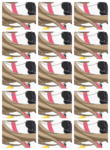Welcome to Doom9's Forum, THE in-place to be for everyone interested in DVD conversion. Before you start posting please read the forum rules. By posting to this forum you agree to abide by the rules. |
|
|
#31381 | Link |
|
Registered User
Join Date: Aug 2004
Location: Canada
Posts: 860
|
It's honestly hard to tell jinc and xbr apart for chroma for *film movies* The most obvious thing I see is xbr being slightly more saturated and it may be less granular and more well defined...may be...
xbr is now faster than jinc for chroma upscaling, madshi  and re: image doubling in general...is the idea behind doubling supposed to get you closer to the original? (i.e. it's easier to present a more accurate picture on the downscale step (catmull) than for an upscaler to enlarge the picture) Last edited by JarrettH; 29th June 2015 at 00:30. |
|
|

|
|
|
#31382 | Link |
|
Registered User
Join Date: Dec 2011
Posts: 1,812
|
Agreed. The effect reminds me a little of LL for FineSharp with the thickening of contoures.
This effect is less distinctive with HQ, which I like. With HQ downscaling, it seems I can set softness to 0 without artificial look. Last edited by aufkrawall; 29th June 2015 at 00:32. |
|
|

|
|
|
#31384 | Link | |
|
Registered User
Join Date: Aug 2004
Location: Canada
Posts: 860
|
Quote:

Last edited by JarrettH; 29th June 2015 at 03:16. |
|
|
|

|
|
|
#31386 | Link | ||||||||||
|
Registered Developer
Join Date: Sep 2006
Posts: 9,140
|
Quote:
Quote:
Quote:
Quote:
I find that SuperRes without HQ downscaling reproduces a look more similar to AdaptiveSharpen, and SuperRes with HQ downscaling is nearer to FineSharp. However, SuperRes with HQ downscaling is able to achieve sharpness levels FineSharp can't reach, without being destructive. So I like SuperRes with HQ downscaling. It needs a performance boost, though. Quote:
Quote:
Quote:
Quote:
Quote:
Quote:
I'm not sure. I would have thought that it works. If it doesn't then please file a bug report on the madVR bug tracker. Thanks. |
||||||||||
|
|

|
|
|
#31387 | Link | |
|
Registered Developer
Join Date: Sep 2006
Posts: 9,140
|
Quote:
Bilateral chroma upscaling is different from the other algorithms because it tries to use the luma channel as guidance. So if the luma channel has a good quality and if it has edges which match the chroma channel, Bilateral should look great. But if the luma channel is aliased or doesn't really match the chroma channel well, Bilateral can look rather bad. But I'd like to delay Bilateral testing until SuperRes feedback is complete. At this point I think I should wait at least 2 weeks for SuperRes feedback. |
|
|
|

|
|
|
#31388 | Link | ||
|
Registered User
Join Date: Aug 2011
Posts: 51
|
It lacks a capital letter for Kodi DSPlayer on the madVR homepage.
 Quote:
As my GPU just died and as FineSharp looks perfect like with Avisynth on my 4 years old laptop, forget what I said. Quote:
 Do you know how for example to enable "smooth motion" from C# or PowerShell? Have you got any code sample, can't find on Github. 
|
||
|
|

|
|
|
#31391 | Link | |
|
Registered User
Join Date: Jul 2013
Posts: 76
|
Quote:
When going into fullscreen initially at 59.95hz, all queues fill fine. When going into fullscreen initially at 24hz, the present queue only fills to 6-7. When toggling to windowed mode and then back to fullscreen again without pausing, both refresh rates show the same behavior of the bug I commented about. That is, queues not filling at all and playback stuttering until I pause and unpause again. Again, only seems to occur with D3D11 10bit. D3D9 10bit & D3D11 8bit don't have this problem. Last edited by SecurityBunny; 29th June 2015 at 12:20. |
|
|
|

|
|
|
#31392 | Link | |||
|
Registered User
Join Date: Dec 2011
Posts: 1,812
|
Quote:
At least with AdaptiveSharpen with strength 0.1 I like to use it. Maybe softness can be removed, but then it would be neat if lower values than strength of 0.1 would be possible with AS. Quote:
Quote:
Jinc AR:  super-xbr AR sharpness 100:  In this example, Jinc is better because it mixes green and pink less than super-xbr. And despite of AR-filter, it struggles more with ringing than Jinc. |
|||
|
|

|
|
|
#31393 | Link | |
|
Registered User
Join Date: Mar 2009
Posts: 3,650
|
Quote:
Also the other area worthy of mention is the inside of photo frame which has more mess around the edges. Looks to me like Jinc AR still wins. It would be interesting to see higher sharpness xbr results here. Last edited by ryrynz; 29th June 2015 at 13:32. |
|
|
|

|
|
|
#31394 | Link |
|
Registered User
Join Date: Apr 2011
Posts: 24
|
Is it just me or is there a problem with the 0.88.14 superres? Aliasing is horrible in this example. I had much better results with superres in previous version.
upscale of a low quality SD source with s-xbr50 quadrupling (images are not zoomed in) http://i.imgur.com/HTVWNIm.png with superres turned on - 0.50 strength, 0.00 softness, HQ off, 6 pass just to show the problem more clearly, aliasing is visible with 2 pass http://i.imgur.com/11jucqY.png same settings as above, now with 0.50 softness http://i.imgur.com/KOQwovI.png Now that we can't control sharpness, antialiasing or antiringing for superres anymore, what are the values for those settings in 88.14? In 88.13 i really didn't like the effect of high values for antiringing and antialiasing. It made the picture waxy/artificial. When upscaling good quality 720p movies i used <0.15 values, otherwise i would get a noticeable wax/oil painting effect. Also in 88.13 i could use superres as a blur/deblock filter for low quality sources. Negative sharpness values were great for removing blocking/noise! Negative sharpness is not the same as softness, right? Last edited by tFWo; 29th June 2015 at 13:42. |
|
|

|
|
|
#31395 | Link | |||||||
|
Registered Developer
Join Date: Sep 2006
Posts: 9,140
|
Quote:
Quote:
Quote:
The problem is the following: As long as I allow D3D11 to use its default refresh rate, the presentation queues seem to fill nicely. But D3D11 is very reluctant to switch to some refresh rates sometimes. I've implemented a hack to work around the problem, which forces D3D11 to switch to our wanted refresh rate. But with some GPUs and some GPU drivers this seems to trigger this problem with queues not filling. Unfortunately I don't think there's much I can do about it. It seems that your D3D11 GPU drivers simply don't like outputting anything but 59.940Hz, for some reason. I'm not totally sure if it's D3D11 itself, or the GPU drivers which are at fault. Could be either, but I would guess it's probably the GPU drivers. You could try creating custom resolution for 24Hz output. Or try using this tool: http://www.monitortests.com/forum/Th...on-Utility-CRU Maybe that helps, or maybe not. At this point the only thing I can offer is to either remove the hack I implemented, or to live with the consequences. If I remove the hack, you'll always get 59.940Hz, though, which is probably very far from what you want, too. You can try some D3D11 games. Can any of them switch to anything other than 59.940Hz with your GPU? I doubt it... Quote:
Quote:
Btw, super-xbr with sharpness 100 is *much* sharper than Jinc. Try a lower sharpness setting with super-xbr to get a fairer comparison to Jinc. Quote:
Quote:
The new SuperRes algo is brand new, it may need a bit of fine tuning. That's why I've asked users for feedback with very specific settings. One of the setup recommendations I made was to set zooming to exactly 200%. |
|||||||
|
|

|
|
|
#31396 | Link |
|
Registered User
Join Date: May 2015
Posts: 5
|
chroma upscaling comparison (madVR v0.88.14)
 Source: H.264 8bit 4:2:0 http://forum.doom9.org/showthread.ph...13#post1727413 a. SuperRes off b. SuperRes on (passes: 2 strength: 0.75 softness: 0.10) c. SuperRes on (passes: 2 strength: 1.00 softness: 0.00) \ a b c 1) chroma upscaling: Catmull-RomAR 2) chroma upscaling: Bicubic75AR 3) chroma upscaling: SoftCubic50AR 4) chroma upscaling: Lanczos3AR 5) chroma upscaling: JincAR  \ a b c 1) chroma upscaling: Bilateral 2) chroma upscaling: super-xbr100AR 3) chroma upscaling: super-xbr150AR 4) chroma upscaling: Nedi 5) chroma upscaling: NNEDI32  \ a b c 1) chroma upscaling: Catmull-RomAR 2) chroma upscaling: JincAR 3) chroma upscaling: Bilateral 4) chroma upscaling: super-xbr150AR 5) chroma upscaling: NNEDI32  It seems like no need Chroma SuperRes. 
|
|
|

|
|
|
#31397 | Link | ||
|
Registered User
Join Date: Dec 2011
Posts: 1,812
|
Quote:
I think it makes more sense to be able to control strength instead of passes. I think it's a good compromise to have only one pass, but HQ downscaling enabled. Both for performance as for quality. There are still huge differences between low strength and high strength with these settings. So my vote goes for just keeping strength as an option, setting passes to 1, enabling HQ downscaling and setting softness to 0. The strength option could be even more simplified by replacing the value box with templates like we have it with deband. Then it'd be just "SuperRes: low, medium, high". Edit: But maybe it would also make sense to use 2 passes and instead lowering the strength a bit if one wants the SuperRes effect more distinct with the high setting. Quote:
Lower sharpness makes the pink even darker, like if it gets mixed more with green due to blur. Last edited by aufkrawall; 29th June 2015 at 16:05. |
||
|
|

|
|
|
#31398 | Link | |||
|
Registered User
Join Date: Oct 2012
Posts: 26
|
Quote:
Anyway, the aliasing and ring control of AdaptativeSharpen is so much better than in case i would use a sharpen, it definitively be this one. He have a sort of very digital look, indeed, and wax is able to come very fast. Then, with a well-thinked process around, and, always, moderate set, he's just a killer for those who wants a faithful and clean picture and a noticeable amount of details (with no creation of non-existant details). Which is, obviously, a great possibilty. Quote:
Quote:
And never forget I have to upscale most 1080p content to very high resolutions (3440x1440 in my desk, and 4K in the dedicated room). I have Titan and Titan X to motorize those set-up, so performance will never be an issue  i.e, if I upscale 1080p Blu-ray to 4K, regardless the algo in Double, low amount of passes in SuperRes will result with a lack of precision. So I have to multiple the passes, and with this state, strength > 0.5 will result to some pixels moving, and you have to renounce using any sharpen if needed. If you add some softness, you can adjust, but why add another process to maybe reach a targeted result you can win with 1 process in less ? 0.35 is a good median setting for clean regular skin, with fantastic precision, and the possibility to add some sharpening if I want/need. To be simple, in 1080p to 4K, 5 passes @ 0.35 are far more accurates and faithfuls than 1 passe @ 1.0. But, with 480p to 1080p, definitively, 1 passe @ 1.0 will be better than 5 @ 0.35. BTW, I have a question/request for future. Is it technically possible to add in madVR a sort of internal supersampling ? I explain. With 1080p screen, you can't obtain the benefits of image doubling and SuperRes without some tricks. If madVR could let the user set an internal resolution to reach by image doubling (+SuperRes etc..), with downscaling set up, the benefits of quality in HQ content could be very substantial. It's just a thought, because it's currently feasible, but it's really not ergonomic. Last edited by Eyldebrandt; 29th June 2015 at 16:41. |
|||
|
|

|
|
|
#31399 | Link |
|
Registered User
Join Date: Sep 2013
Posts: 919
|
@ madshi, everyone.
Here is a great chroma sample: http://www.mediafire.com/?nyzrd9qt6nv9t41 *I removed all traces of the original name of the movie, but if it is still found somewhere, all rights reserved to the original creators.
__________________
System: i7 3770K, GTX660, Win7 64bit, Panasonic ST60, Dell U2410. |
|
|

|
|
|
#31400 | Link | |
|
Registered User
Join Date: Apr 2011
Posts: 24
|
Quote:
Here is an example with a ringing/blooming problem (and other artifacts with hq on). I'm using "refine the image only once" option now. It's an SD source upscaled with s-xbr50 quadrupling. Image is additionally zoomed in 2x in MPC-HC. no superres http://i.imgur.com/9R65zEz.png 2pass strength 0.50 softness 0.00 nohq http://i.imgur.com/mAFZDxk.png 2pass strength 0.50 softness 0.00 hq http://i.imgur.com/91RmoRJ.png 2pass strength 1.00 softness 0.00 nohq http://i.imgur.com/hmREzhz.png 2pass strength 1.00 softness 0.00 nohq http://i.imgur.com/LL7DAKs.png and to compare with 0.88.13 and the settings i used before (refine the image after every ~2x upscaling step, 2pass, strength 0.50, sharpness -0.50, softness 0.15, AA 0.10, AR 0.10) http://i.imgur.com/WDyf1Rc.png I prefer the old Superres look and versatility  . .
|
|
|
|

|
 |
| Tags |
| direct compute, dithering, error diffusion, madvr, ngu, nnedi3, quality, renderer, scaling, uhd upscaling, upsampling |
|
|